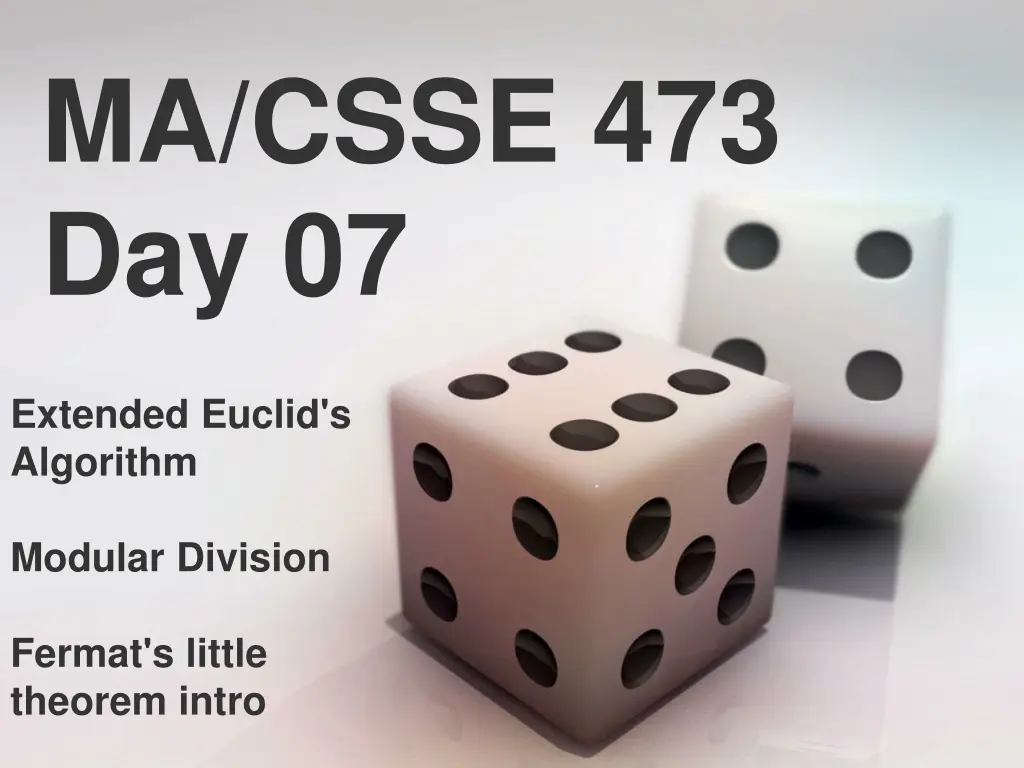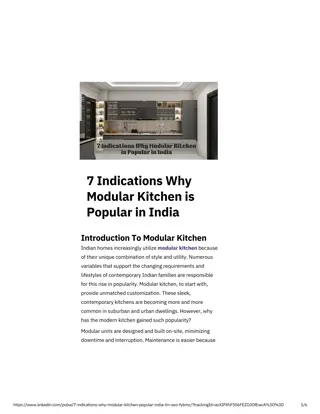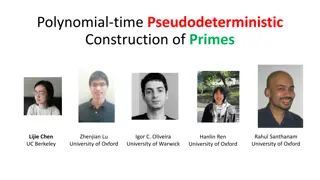
Extended Euclid's Algorithm, Modular Division, and Fermat's Little Theorem Introduction
Explore topics like Extended Euclid's Algorithm, Modular Division, and Fermat's Little Theorem as covered in MA/CSSE 473. Learn about calculating modular inverses, modular division, and more with insightful examples and explanations.
Download Presentation

Please find below an Image/Link to download the presentation.
The content on the website is provided AS IS for your information and personal use only. It may not be sold, licensed, or shared on other websites without obtaining consent from the author. If you encounter any issues during the download, it is possible that the publisher has removed the file from their server.
You are allowed to download the files provided on this website for personal or commercial use, subject to the condition that they are used lawfully. All files are the property of their respective owners.
The content on the website is provided AS IS for your information and personal use only. It may not be sold, licensed, or shared on other websites without obtaining consent from the author.
E N D
Presentation Transcript
MA/CSSE 473 Day 07 Extended Euclid's Algorithm Modular Division Fermat's little theorem intro
MA/CSSE 473 Day 07 Student Questions Be sure to read today s announcements, especially the last item. Extended Euclid Algorithm, the calculate forward, substitute backward approach Modular Division Fermat's Little Theorem Intro to primality testing.
Recap: Euclid's Algorithm for gcd Another place to read about modular arithmetic, including exponentiation and inverse: Weiss Sections 7.4-7.4.4
recap: gcd and linear combinations Lemma: If d divides both a and b, and d = ax + by for some integers x and y, then d = gcd(a,b) Proof we did it yesterday
recap: Extended Euclid Algorithm Proof that it works I decided that it is a bit advanced for students who just saw Modular Arithmetic for the first time yesterday. If you are interested, look up extended Euclid proof We ll do a convincing example.
Recap: Forward-backward Example: gcd (33, 14) 33 = 2*14 + 5 14 = 2 * 5 + 4 5 = 1 * 4 + 1 4 = 4 * 1 + 0, so gcd(33, 14) = 1. Now work backwards 1 = 5 - 4. Substitute 4 = 14 - 2*5. 1 = 5 (14 - 2*5) = 3*5 - 14. Substitute 5 = 33 - 2*14 1 = 3(33 - 2*14) -14 = 3 * 33 7 * 14 Thus x = 3 and y = -7 Done! A good place to stop and check!
Calculate Modular Inverse (if it exists) Assume that gcd(a, N) = 1. The extended Euclid's algorithm gives us integers x and y such that ax + Ny = 1 This implies ax 1 (mod N), so x is the inverse of a Example: Find 14-1 mod 33 We saw before that 3*33 - 7*14 = 1 -7 26 (mod 33) So 14-1 26 (mod 33) Recall that Euclid's algorithm is (k3), where k is the number of bits of N. Check: 14*26 = 364 = 11*33 + 1.
Modular division We can only divide b by a (modulo N) if N and a are relatively prime In that case b/a = b a-1 What is the running time for modular division?
Primality Testing The numbers 7, 17, 19, 71, and 79 are primes, but what about 717197179 (a typical social security number)? There are some tricks that might help. For example: If n is even and not equal to 2, it's not prime n is divisible by 3 iff the sum of its decimal digits is divisible by 3, n is divisible by 5 iff it ends in 5 or 0 n is divisible by 7 iff n/10 - 2*n%10 is divisible by 7 n is divisible by 11 iff (sum of n's odd digits) (sum of n's even digits) is divisible by 11. when checking for factors, we only need to consider prime numbers as candidates When checking for factors, we only need to look for numbers up to sqrt(n)
Primality testing But this approach is not very fast. Factoring is harder than primality testing. Is there a way to tell whether a number is prime without actually factoring the number? Like a few other things that we have done so far ion this course, this discussion follows Dasgupta, et. al., Algortihms (McGraw-Hill 2008)
Fermat's Little Theorem (1640 AD) Formulation 1: If p is prime, then for every number a with 1 a <p, ap-1 1 (mod p) Formulation 2: If p is prime, then for every number a with 1 a <p, ap a (mod p) These are clearly equivalent. How do we get from each to the other? We will examine a combinatorial proof of the first formulation.
Fermat's Little Theorem: Proof (part 1) Formulation 1: If p is prime, then for every number a with 1 a < p, ap-1 1 (mod p) Let S = {1, 2, , p-1} Lemma For any nonzero integer a, multiplying all of the numbers in S by a (mod p) permutes S I.e. {a n (mod p) : n S} = S Example:p=7, a=3. Proof of the lemma Suppose that a i a j (mod p). Since p is prime and a 0, a has an inverse. Multiplying both sides by a-1 yields i j (mod p). Thus, multiplying the elements of S by a (mod p) takes each element to a different element of S. Thus (by the pigeonhole principle), every number 1..p-1 is a i (mod p) for some i in S. i 1 2 3 4 5 6 3*i 3 6 2 5 1 4
Fermat's Little Theorem: Proof (part 2) Formulation 1: If p is prime, then for every number a with 1 a <p, ap-1 1 (mod p) Let S = {1, 2, , p-1} Recap of the Lemma: Multiplying all of the numbers in S by a (mod p) permutes S Therefore: {1, 2, , p-1} = {a 1 (mod p), a 2 (mod p), a (p-1) (mod p)} Take the product of all of the elements on each side . (p-1)! ap-1(p-1)! (mod p) Since p is prime, (p-1)! is relatively prime to p, so we can divide both sides by it to get the desired result: ap-1 1 (mod p)
Recap: Fermat's Little Theorem Formulation 1: If p is prime, then for every number a with 1 a <p, ap-1 1 (mod p) Formulation 2: If p is prime, then for every number a with 1 a <p, ap a (mod p) Memorize this one. Know how to prove it.






















